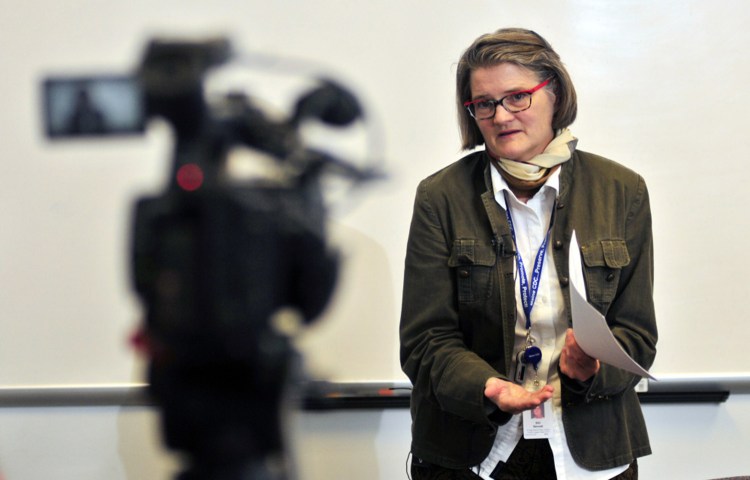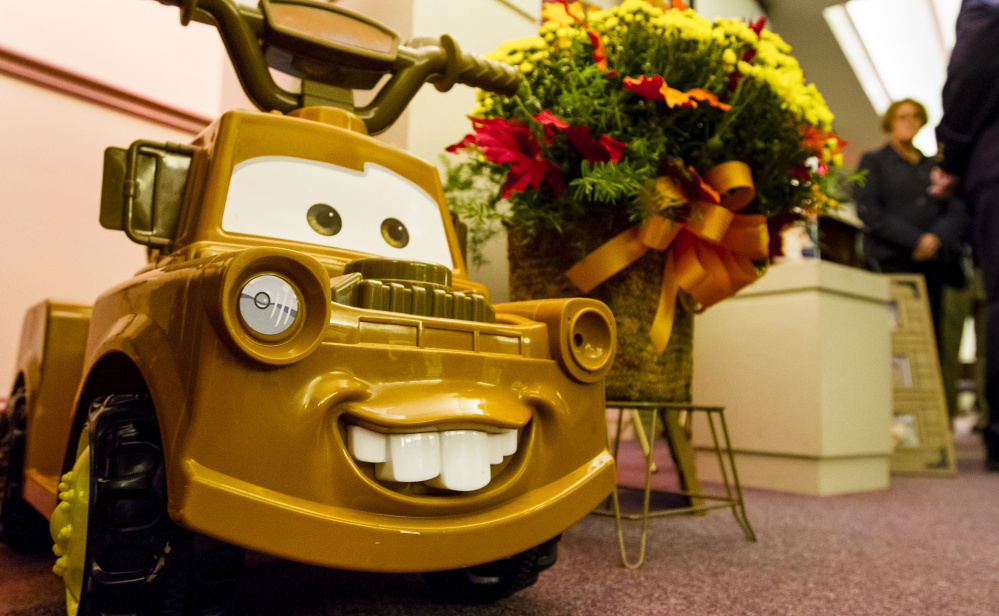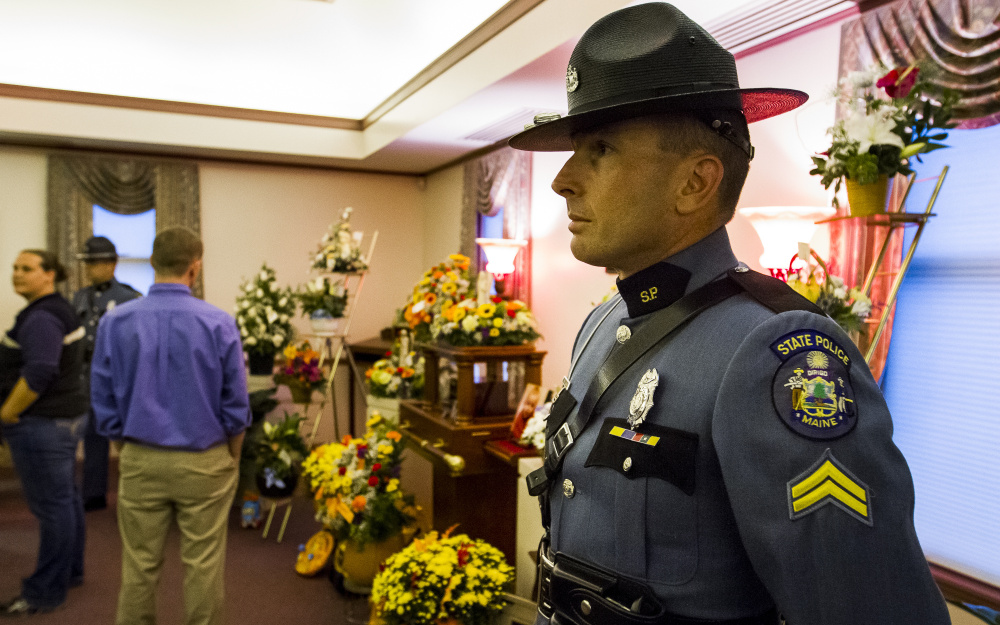State health officials say that two toddlers who fell ill with an E. coli infection contracted the same strain of the dangerous bacteria. One of the toddlers died this week, while the other is recovering at Maine Medical Center.
“The strain and molecular typing from each patient was identical, making it highly likely that the cases acquired the illness from same source,” said Dr. Siiri Bennett, the state epidemiologist for the Maine Center for Disease Control and Prevention, at a news conference Friday. “We cannot say with certainty what that common exposure might have been.”
Efforts to find the source of the virulent strain have focused on the Oxford County Fair petting zoo, which both toddlers visited in late September. State health officials have tested animal bedding and feces from the fair site to see if they can find a match. Test results are expected late next week.
The strain, known as O111, is one of many versions of the E. coli bacteria. After contracting E. coli, patients can develop bloody diarrhea or hemolytic uremic syndrome, a type of kidney disease. Most types of E. coli are harmless, but some cause symptoms such as belly pain or diarrhea, or illness that can lead to death.
Twenty-month-old Colton James-Brian Guay of Poland died this week of hemolytic uremic syndrome, his family reported. Meanwhile, 17-month-old Myles Herschaft of Auburn was upgraded from fair to satisfactory condition Friday night at Maine Medical Center in Portland. Myles also is battling hemolytic uremic syndrome.
Of the 26 cases of E. coli so far this year, six developed hemolytic uremic syndrome, according to John Martins, Maine CDC spokesman, including the two toddlers. Only Colton’s case was fatal.
“All involved children under the age of 5,” Martins said.
Martins said the CDC was not able to determine the cause of the other E. coli cases in 2015 or the 33 cases in 2014.
He said it’s extremely difficult to find a cause for E. coli, especially if it’s not traced to a known food outbreak.
Bill Marler, a Seattle-based food safety attorney who writes a popular food safety blog, said it’s not surprising that in most cases, the Maine CDC has not been able to find out what causes the E. coli infections. Many times people can’t point to something specific that they ate, or if they can, the food is gone or the place they visited has been cleaned.
“It’s rare to be able to isolate the source,” said Marler, who has been hired to represent the Guay family. Marler said the family is waiting for the investigation to finish before considering what to do next.
On Friday night, the Guays held a public wake for their son at Fortin Funeral Home in Auburn, where many of Colton’s toys were displayed alongside floral arrangements and photographs of the happy, tow-headed toddler. More than 100 people attended, including dozens of law enforcement officers from multiple Maine agencies who took turns standing as honor guards near the boy’s urn.
“My son loved anything to do with police officers and K9s,” said Jon Guay, an Androscoggin County sheriff’s deputy.
Guay said he was overwhelmed by the support of family, friends and his brothers in blue.
He also said changes are needed to make petting zoos safer and prevent tragedies from happening to other families, but he said it’s too soon to say whether state regulations are appropriate. Any decisions should await the outcome of an investigation.
“For now, ‘awareness’ is the key word,” he said. “People need to be aware of the potential dangers.”
Marler said that while many people think of E. coli as an infection contracted from eating undercooked hamburgers or drinking raw milk, the connection to animals shouldn’t be discounted.
Many of the states with higher rates of E. coli infections are rural states where people interact more with farm or ranch animals, he said. In 2014, states such as South Dakota, Nebraska, Iowa and Idaho had twice the rate or higher of E. coli infections than the national average. Maine’s E. coli rate was slightly higher than the national average, according to the U.S. CDC. There were about 5,000 confirmed cases of E. coli nationwide in 2014, according to the U.S. CDC, but far more people are believed to get sickened from the bacteria, because they recover and are never tested.
Marler said petting zoos are a risk, and would be considered a higher risk if they were more prevalent.
“If we had people attending petting zoos at the same rate as people are eating hamburgers, we would probably find that the numbers would show that petting zoos are more dangerous,” Marler said.
Marler has long recommended that states enact tougher regulations on petting zoos. After a child in North Carolina contracted E. coli from a petting zoo in 2004, the state passed stricter laws governing petting zoos, including that they be inspected for sanitary conditions before opening to the public and that hand-washing stations be located nearby.
The North Carolina case spurred Maine to strengthen its policies, said Dr. Michele Walsh, Maine’s state veterinarian.
Maine now randomly inspects all petting zoos at the 26 county fairs once they are underway, and the zoos are required to have hand sanitizers and signs warning about the dangers of petting animals.
While hand sanitizers are considered a preventive step, they are not as effective at eradicating bacteria as washing with hot soapy water, or even cold soapy water, health experts say. Walsh said it would be cost-prohibitive to run hot water to the animal barns, but some fairs have hand-washing stations with cold water and soap.
Jon Guay told the Press Herald this week that he held his son’s hand at the petting zoo and they used hand sanitizer immediately after leaving the petting area.
Walsh said they will wait for the test results before considering what steps, if any, are needed to improve sanitary conditions at county fairs.
“This is heartbreaking and devastating,” Walsh said. “The investigation is ongoing, and we don’t know what other possible explanations there might be. There are always inherent risks when you have humans interacting with animals.”
Staff Photographer Ben McCanna contributed to this report from Auburn.
Send questions/comments to the editors.






Comments are no longer available on this story